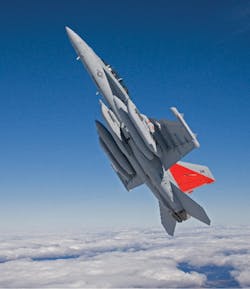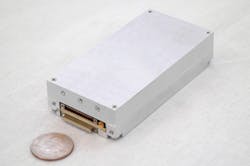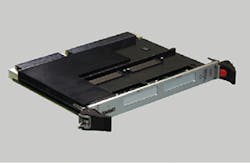Embedded computing, systems-on-chip, artificial intelligence, and advanced algorithms are only a few enabling technologies for EW systems that learn on their own and adapt to the latest conditions.
By J.R. Wilson
The helicopter; cell phone; parachute; computer tablet; battle tank; robotic, flying, and driverless car; artificial intelligence (AI); humans working and living in space; replicators; directed-energy weapons; the Internet; genetic engineering; submarines; hypersonic flight; real-time free global communications; and "Six Million Dollar Man-like" prosthetics.
All of the above share one thing: They were imagined - in diagrams, drawings, models, novels, and film scripts - years, decades, even centuries before the enabling technologies to bring them to reality were developed.
Today new concepts and rapidly evolving technologies can mean even what once would have been considered virtually no delay may place a nation's defense or economic well-being in jeopardy. With changes in critical military systems and applications on the battlefield in the midst of combat, the response to them must be equally fast, in-place, and real-time. In other words, adaptive.
Nowhere is this more important than in electronic warfare (EW), sometimes seen as a too-long neglected subset of cyber warfare - the military's latest domain of war.
In June 2017, Bill Conley, deputy director of the Pentagon's new Office of Electronic Warfare, told the Air Force Association that the U.S. has done little to address a quarter century of adversary advances in EW capabilities. It has led the U.S. Department of Defense (DOD) to develop a new EW strategy acknowledging domain superiority - be it land, air, sea, space, cyberspace - is predicated on the ability to control the electromagnetic spectrum.
This new strategy focuses on a crucial central goal: "agile, adaptive, and integrated electronic warfare to offensively achieve electromagnetic spectrum superiority across the range of military operations."
Although the U.S. historically has been the largest market for EW technologies, Dutch market researcher ASD Reports predicts a 36.1 percent worldwide growth in EW over the next decade, from $14.4 billion in 2016 to $19.6 billion in 2026, at which time the total global investment in EW will reach $184.1 billion.
Enabling technologies
That growth is being driven by rapidly advancing enabling technologies - such as cognitive radar and radio communications. Also driving EW demand are open commitments from China and Russia to achieve EW superiority.
As with those earlier technologies moving, often slowly, from concept to deployment, the key to EW superiority is technology finally catching up with human imagination.
"EW is on the verge of a sea-change," says John Tranquilli, technical director of signals & communications processing at the BAE Systems Electronic Systems segment in Nashua, N.H. "The days of big, expensive, database-driven, and slow-to-upgrade platforms, with big radars that are static, are pretty much over. "Adaptive means the EW system can change its operations or response based on some feedback signal it observes from its environment, such as mode changes in a radar. That doesn't mean you aren't relying on a database.
"A system that's cognitive is capable of two things: First, its operations are not reliant on a predefined threat database," Tranquilli continues. "It can determine the meaning of the signals it receives and reason over the potential responses it can make. It's also adaptive, observing changes in its environment. Second, it makes use of learned knowledge so it can respond quicker and more effectively in subsequent engagements."
Bistatic, on the other hand, has been part of the military lexicon for more than 75 years; most early radars in World War II featured a transmitter in one location and the receiver in another.
"That can break some traditional assumptions on how an EW system might respond," Tranquilli continues. "It is the simplest form of multistatic, which is possible for any system using the RF spectrum. It's not a new concept in terms of bistatic operations, but the application and the extension to multistatic are new."
Embedded computing
"As we move toward bringing things such as the broad term of machine learning, statistical methods and more physics-based modeling into our processing, they take more resources than just looking something up in a database, so HPEC [high-performance embedded computing] comes into play. We are looking to leverage developments in the commercial embedded computing space for adaptive, bistatic, and multistatic. Technology will never be over and done with in terms of what can be achieved, so we will continue to work to further adaptive, cognitive and multistatic EW."
Bistatic and multistatic radars offer several improvements over traditional radar, including a heightened potential for detecting stealth aircraft.
"Bistatic or specially distributed systems provide simultaneous looks at the same signal, which gives you spacial diversity and may provide some elements you couldn't get from a single system. But it is technologically difficult - coordinating across separated receivers, how to share information - and other levels of complexity that still need to be solved," says Anthony Nigara, director of EW mission solutions at the Harris Corp. Electronic Systems segment in Rochester, N.Y.
Sharing information among bistatic or multistatic radars moves into a new level when combined with adaptive or cognitive capabilities.
"The main benefits of adaptive are resilience to change over previously unseen threats. Not being hemmed in by preconceived or predefined databases allows for that resilience against a potentially very broad set of threats. And once you've seen something, you can respond more quickly in the future," Tranquilli adds.
"That ties into multistatic, because what is learned by one can be learned across the multistatic distribution. That gives you an instantly larger baseline and multiple perspectives. With multiple platforms, you also can distribute processing to save battery life. And in a multistatic environment, if one element is lost, the system can survive and continue, which is a big advantage."
Detecting stealth
Frequency-hopping, software-defined radios and radars have been in use for some time, but advances in the sophistication of potential adversarial systems have significantly reduced the battlespace edge the U.S. has enjoyed since the 1980s. As radar and signal processing become increasingly more complex, radar and other systems must not only detect targets with ever-shrinking radar cross-sections, but identify them, provide size and range information, even target images, operate in all environments (including high sea states) and not only sense but quickly adapt to EW weapons and countermeasures.
This is further complicated by the use of adaptive and cognitive EW systems by adversaries at levels equal to, or potentially more advanced than, U.S. systems and countermeasures. If an enemy fields such capabilities, their systems will be adapting to U.S. countermeasures even as U.S. systems are adapting to them. It is the old paradigm of armor/anti-armor, where each advance in one was countered - weeks or months later - by an advance in the other, reduced instead to seconds, if not nanoseconds.
The speed of technology evolution in the commercial market - primary source of new components for the military - has overwhelmed the Pentagon's traditional research and acquisition rates, wrote Nydia De Nova, principal systems engineer at Raytheon Space & Airborne Systems, in the 26 June 2017 issue of Electronic Component News.
"The biggest challenge that exists today is the short timeline for countermeasure advances versus the long development and upgrade cycle time of EW systems. The unprecedented acceleration of new technology development has allowed the adversary to field new threats at increased rates. The U.S. is losing its military superiority over the EMS domain," De Nova warned. "The EW paradigm has shifted, creating the need for rapid development and fielding of systems capable of transforming post-deployment. As enemy threats become more sophisticated, EW designers need to create systems that can adapt and respond to changes in real-time. Such systems have to conform to unseen changes with minimal addition of components/subsystems to support many cycles of countermeasures."
Disruptor SRx is an electronic warfare (EW) system that performs several different functions and represents the next generation of EW technology.
The role of artificial intelligence
To hold a lead in EW, the military must identify new technologies and capabilities designed for commercial use that, with no or minimal modification, can be applied quickly to military needs. That is especially true of revolutionary advances, such as cognitive EW's use of AI to provide adaptive decisions about and actions against new threats in real-time, typically at speeds that preclude human control.
"In pursuing the vision, DOD systems must become more spectrally efficient, flexible, and adaptable, and DOD spectrum operations must become more agile in their ability to access the spectrum in order to increase the opportunities available to mission planners," according to De Nova.
"This includes increasing the operating frequency range of systems, increasing the ability to share spectrum with other systems, amending DOD processes pertaining to spectrum use, increasing the speed of system adaptation, avoiding potential interference with commercial networks, and developing near-real-time spectrum operations that integrate spectrum management, network operations, EW, cyberspace, and intelligence operations."
In 2016, the U.S. Air Force Scientific Advisory Board (AFSAB) initiated the yearlong study "Responding to Uncertain or Adaptive Threats in Electronic Warfare." The original abstract cited challenges to the Air Force's ability to identify the source and intent of RF signals due to "increasing signal density and highly variable or real-time adaptive waveforms and modalities... software-defined architectures and advanced digital signal processing in adversary systems," especially in an Anti-Access/Area Denial (A2/AD) environment.
"To conduct electronic protection, attack and support, blue systems will need to adaptively probe, sense and respond in real-time, utilizing machine-learning algorithms in what has been described as Cognitive EW," according to the abstract. "However, it is unclear to what extent the current state-of-the-art [SOTA] in machine learning and adaptive decision-making algorithms is suitably mature to fully enable this approach.
"Potential red countermeasures and the likelihood of blue fratricide are also poorly understood," the abstract continues. "There is a need to clarify what is realistically possible to support probe-sense-respond in the near-term and over the foreseeable future, what the performance of such adaptive approaches will likely be and what offers the most promise for developing cognitive EW capabilities."
A U.S. Air Force airman provides training using a simulated satellite constellation at Langley Air Force Base, Va.
To that end, the study was commissioned to:
• define current and likely further threat system characteristics that complicate or prevent traditional a priori development of effective electronic countermeasures;
• survey the current SOTA in machine learning and adaptive decision-making algorithms and assess the likely rate of progress in key areas over the foreseeable future;
• determine the performance that will be realistically achievable in the near, mid-, and far-term from various technical approaches to the probe-sense-respond paradigm;
• identify the most promising avenues along which development of cognitive EW should be focused and provide realistic timelines and milestones for each;
• determine key R&D efforts that should be undertaken to accelerate progress in essential technical areas for enabling probe-sense-respond approaches; and
• recommend integrated demonstrations and transition opportunities for near-, mid- and far-term implementation of cognitive EW.
At the time the study was announced, AFSAB Vice Chairman James Chow told reporters the A2/AD threats also are becoming much more adaptive, forcing the Air Force to find new ways to significantly reduce response cycle time. One solution is raising the level of AI in adaptive EW systems.
Deep learning
"Deep learning and artificial intelligence are industry-driving trends in the data-center market, which will be directly beneficial to the military EW market," says Denis Smetana, FPGA senior product manager at the Curtiss-Wright Corp. Defense Solutions segment in Ashburn, Va. "FPGA [field-programmable gate array] vendors, who are competing against GPGPU [general-purpose graphics processing unit] suppliers, continue to optimize their tools to improve the productivity of customers using FPGAs for these types of applications. They are also optimizing their devices to improve the processing capacity of deep learning algorithms."
The U.S. Defense Advanced Research Projects Agency (DARPA) in Arlington, Va., has been working the defensive side of dealing with evolving enemy adaptive technologies through two primary programs: Adaptive Radar Countermeasures (ARC) with the U.S. Naval Air Systems Command and the Air Force and Behavioral Learning for ADaptive EW (BLADE) with the Army's Communications-Electronics Research, Development and Engineering Center (CERDEC). Both are investigating how machine learning - a form of AI - can be employed in real time to identify and jam enemy signals, especially those not yet cataloged.
"U.S. military aircraft lack countermeasures against new radar frequencies and waveforms not in their on-board jamming profile library and it can take months to develop and deploy new profiles and countermeasures," notes the agency's 2017 document, "Changing How We Win."
Advanced electronic warfare long has been part of shipboard and airborne military applications, and also is becoming an important part of land-based infantry operations for Army and Marine Corps warfighters.
"DARPA has developed a completely new way to address this threat: Cognitive electronic warfare, in which the on-board system senses across the radio spectrum, uses artificial intelligence to learn in real-time what the adversary's radar is doing, and then immediately generates a specific jamming profile to counter it."
Six companies are completing the final year of their individual five-year contracts with DARPA to develop and employ technologies supporting ARC: BAE Electronic Systems, Helios Remote Sensing Systems, Michigan Tech Research Institute (MTRI), Science Applications International Corp. (SAIC), Systems & Technology Research (STR), and Vadum.
They have been focusing on how to isolate hostile, friendly, and neutral signals to determine the specific threat and jam the signal. Primary threats under study include multifunction ground-to-air and air-to-air phased array radars using agile beam-steering, waveform coding, and pulse-repetition intervals.
The BLADE program is developing ways to counter new and dynamic wireless communications threats in tactical environments by enabling a shift from today's manual-intensive, lab-based countermeasures to an adaptive, in-the-field systems approach. DARPA says that involves developing "novel machine learning algorithms and techniques to rapidly detect and characterize new radio threats, dynamically synthesize new countermeasures and provide accurate battle damage assessment based on over-the-air observable changes in the threat."
"Traditional EW systems have relied on preprogrammed data; adaptive systems make some of those determinations without the need of those databases. So they learn in real-time to adapt to their missions as they go along," Harris' Nigara says.
Curtiss-Wright's 4th generation 6U FPGA card, the CHAMP-FX4, combines the dense processing resources of three large Xilinx Virtex-7 FPGAs with more than 12 gigabytes of memory, all on a rugged 6U OpenVPX form factor module.
"A lot of the fundamental technologies being explored for adaptive EW have been around in papers for 15 years or longer," Nigara says. "What has caught up is we now have EW systems that operate over a broad enough bandwidth and can take in and process enough information about those resources and sufficiently fast-acting computing to use these algorithms. Our ability to implement and substantiate these is due to the hardware catching up to a lot of the theory."
This image from BAE Systems illustrates the company's work on DARPA's Adaptive Radar Countermeasures (ARC) project to enable airborne electronic warfare (EW) systems to counter new, unknown, and adaptive radars in real time.
Research and development
Adaptive EW developers have identified a number of enabling technologies and areas of continued R&D that make systems truly adaptive, including:
• smart FPGAs with embedded processors;
• real-time capabilities of leading-edge FPGAs to provide on-the-fly flexibility and reconfigurability with improved size, weight, and power (SWaP) savings;
• RF and microwave components;
• pushing the state of the art (less noise, more bandwidth, etc.) to sense more of the spectrum at any given time without constantly tuning around it to pick up different signals; and
• high-performance embedded computing (HPEC) that provides in-module processing close to the RF signal, with software running alongside the FPGAs to translate signals in-place, reducing latency;
• algorithms;
• machine learning to find breakthrough algorithms that can be modified for EW;
• databases for efficient remote storage and retrieval of the extreme volume of information already pouring out of the battle theater and growing exponentially;
• system-on-chip developments without commercial market applications; and
• extremely fast analog-to-digital (A/D) and digital-to-analog D/A converters.
A/D and D/A converters can be located between the transceiver antennas and digital signal processing that bypass the FPGA to reduce signal passes by tens of nanoseconds for such high-performance, high-bandwidth applications as EW, digital RF modulator (DRFM), signals intelligence (SIGINT), electronic countermeasures (ECM), and ground-penetrating radar (GPR).
"As electronic warfare moves from adaptive (able to adapt responses to different stimuli) to cognitive (able to generate new responses to previously unseen stimuli), the amount of processing continues to increase and the intelligence required to make those decisions has to move closer to the sensors," says Curtiss-Wright's Smetana. "FPGAs, which have always been at the front-end of the sensor processing chain, continue to evolve to incorporate new enabling capability which directly relates to this trend.
"First, the level of integration of cores inside an FPGA is increasing to include more powerful processors, embedded SDRAM and even A/D and D/A converter cores," Smetana says. "The embedded processor cores provide a tight coupling between software and the front-end sensor data. The embedded SDRAM will aid in the application of deep-learning algorithms inside the FPGA which require a low-latency, high-bandwidth memory interface. And, lastly, the embedding of A/D and D/A converters directly inside the FPGA specifically helps low-latency sense-and-response EW applications by removing the external FPGA-A/D-D/A interface, which is increasingly impacting latency."
Looking to the future
As to the future, adaptive EW is seen as a subset of cognitive EW, both part of a continuum that will enable warfighters to do more, faster, with greater reliability and confidence, but also with significant reductions in SWaP, as well as the number of devices and systems required.
"Generically, we're seeing a convergence into multifunction systems," Harris' Nigara says. "An EW system today may be built for a specific role, such as sensing and detecting radars, but we're trying to move toward systems that can move from a specific EW mission to a SIGINT or communications mission without being reprogrammed. So instead of a [dedicated] EW system in the future, you'll really have a spectrum management system. I see that starting to move into the spotlight in the next one to five years.
U.S. Marines use advanced radio to communicate voice, data, and imagery. Cognitive radio capability could help keep communications channels open despite enemy attempts to jam them.
"The systems we are trying to detect and counter within the spectrum are becoming more and more software-defined, which is spurring the need for adaptive and cognitive systems," Nigara continues. "I think you'll see a natural progression; a lot of pieces are starting to come together and will begin to be seen in fielded systems as they are required. However, a full adaptive or cognitive system doesn't mean we throw away decades of proven EW technologies. The new will exist within traditional EW systems or operate very closely alongside them."
According to Harris, as adaptive EW systems get fielded and their capabilities are fully explored in operation and become a trusted technology by the EW community, "adaptive EW has the potential to fundamentally alter how EW is conducted, from development to logistics to operational employment." However, not even radically streamlined DOD acquisition procedures in the future will match the speed of commercial development o nor should they, in the view of some observers.
"If you look at any conflict, there will always be a mix of capabilities," Nigara predicts. "History has shown it is slow to phase out older technologies, especially in the military, because in certain areas they still work. So it will be a long road before we have only adaptive and cognitive systems out there, at least through the 2020s.
"Sometimes having that diversity out there is a good thing," Nigara says. "There is still work to be done on how they are used in the field. For example, do we need an additional command-and-control level to arbitrate between legacy and adaptive systems that don't agree. And while AI is here to stay, it's a matter of how much additional effort is needed to implement it and how complex a thought process will it be using."








